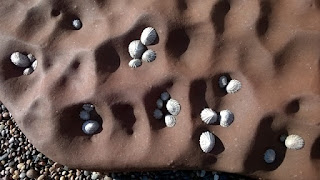Being out west, I walked over St Bees south head to blow away cobwebs and look for moonscapes. I expected wind and got autumn sunshine, too hot in my fleece layers. The last time I was here, on a blustery November day with the carpenter, we huddled in the lee of the lighthouse, determinedly eating our picnic and taking our first ever selfie to prove it.
After a beachful of round pebbles, dog-walking families and sandcastle builders, a heavily eroded cliff path, a headland of miniature memorials, bright gorse and big, big views. The clifftop fairly busy with the dog-walking families, the new path inland from the collapsed one not wide enough for passing in gangs.
| St Bees beach with Black Coombe | The old path |
|
|
 |
| Bright gorse | Looking south beyond the Factory |
To the west, the sea, Snaefell and the Isle of Man; to the north, Criffel and the Galloway hills; to the east the Western fells; to the south, Black Coombe and the Factory. This is where my parents grew up, the views they grew up with, there throughout my childhood but not ingrained on my mind - I can map the western valleys, but not the western fells. The post-industrial coastal towns are different from the eastern market towns in my mind, and I'm certainly snobbish in the way I think about them. When the Gap was open earlier this year, there was talk of the north-south divide in the county, but the east-west divide (with a dialect divide going back to the different varieties of Vikings) was more present in my childhood. As an adult I recognise the importance of the west - far more populous than the east, economically important, but harder to reach.
| View south with gorse |
Over the cliffhead and down to the beach, past an array of discarded plastic in which I can see little to collect, even as a frequent forager of other people's discards.
My Cumbria Coastal Way guidebook, published in 1994, says "Fleswick Bay was once the haunt of smugglers, and it is easy to imagine the small dark caves concealing kegs of brandy and bottles of whisky. The bay is a good place to look for semi-precious stones such as agates and has a wonderful sculpted sandstone shore."
|
|
|
| Fleswick beach south |
Fleswick cliff north |
 |
 |
| Fleswick cave | Barnacles |
My moonscape is no longer in a cave - the cliff must have receded and the caves shrunk, leaving my moonscape outside. In what remains of the cave, 100-year-old public school boy graffiti, in elegant script, and just one moonrock.
 |
|
| Posh graffiti | More posh graffiti |
| Moonscape 1986 (approx) |
Moonscape 2016 |
 |
|
Limpets had gathered in the craters of one outside moonrock; back in the cave I arrange pebble eggs in the shallower crater cups of the younger indoor moonrock.
 |
|
| Limpets | Eggcups |
And then out into the light for a quick look at the barnacle rocks, huge lumps of sandstone crusted grey with barnacles, barnacles on barnacles, barnacles on limpets. One rock has lots of inch-wide dark circles, looking from a distance like indentations, drip cavities, but with no cliff cover to provide the drips. But the darkness isn't shadow - each indentation is a mussel-nursery, two or three dozen tiny mussels crammed together in their cradle, protruding slightly, ready to open when the tide comes in. Some of the indentations are slightly larger, mussel-free, still with water. Something dark and spherical, like a large marble, below the water in one - thinking it might be a baby urchin, I gave it a prod and got an unexpected squidge. I'd forgotten about sea anemones. And as looked further the rocks were covered in slightly bigger pools, very round, looking manmade as though scoured in concrete. Something about the geology of the sandstone leads to very round pools and very round pebbles. The pools contain pink and green seaweeds, dark red anemones, indigo mussels, yellow-white limpets, and astonishing microworlds.
 |
 |
 |
 |
 |
 |
 |
 |
Next year, when I stop making things from other people's patterns, I'll make embroideries of Fleswick beach - barnacle rocks of linen thread on linen cloth stained with Egremont Red, and lots of dense French and bullion knots, and circular rockpools, tiny aquaria peered at through a light surface veil.
 |
 |
| Winkles | Barnacle textures |
I went over an eroded cliff to see the unexpected moonscapes that had amazed me as a child when the photos came back, and found an eroded cliff had exposed my moonrocks to the light. I walked over fallen pieces of cliff and found unexpected microworlds that amazed me as an adult. My world has changed and the coast has changed, and Fleswick Bay has new wonders to discover.












No comments:
Post a Comment